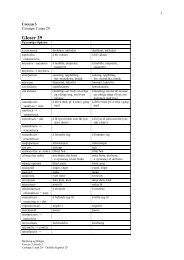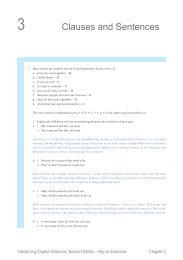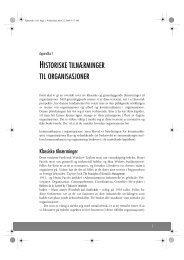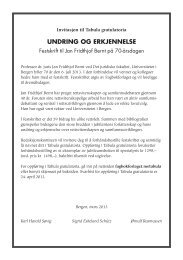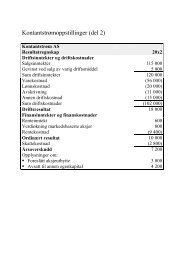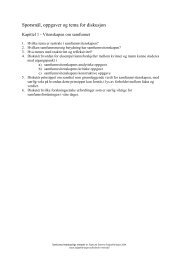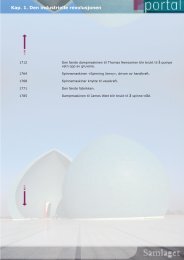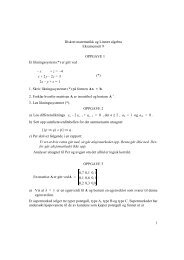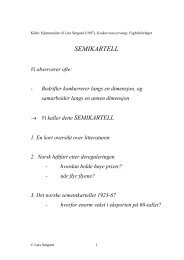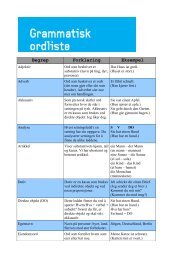price discrimination in the airline industry - Fagbokforlaget
price discrimination in the airline industry - Fagbokforlaget
price discrimination in the airline industry - Fagbokforlaget
You also want an ePaper? Increase the reach of your titles
YUMPU automatically turns print PDFs into web optimized ePapers that Google loves.
PRICE DISCRIMINATIONINTHE AIRLINE INDUSTRYFrode Steen and Lars SørgardDepartment of EconomicsNorwegian School of Economics and Bus<strong>in</strong>ess Adm<strong>in</strong>istrationHelleveien 30, 5045 BergenNORWAYEmails: frode.steen@nhh.no and lars.sorgard@nhh.noAbstract:The purpose of this report is to discuss <strong>the</strong> welfare effects of different k<strong>in</strong>ds of <strong>price</strong><strong>discrim<strong>in</strong>ation</strong> schedules that are used <strong>in</strong> <strong>the</strong> airl<strong>in</strong>e <strong>in</strong>dustry. We dist<strong>in</strong>guish betweenversion<strong>in</strong>g, discount to large consumers, and frequent flyer programs. It is argued thatversion<strong>in</strong>g is probably welfare improv<strong>in</strong>g, especially <strong>in</strong> a competitive sett<strong>in</strong>g.Fur<strong>the</strong>rmore, it is argued that discounts to large firm has an ambiguous effect on welfare<strong>in</strong> monopoly, while it is likely that it is detrimental to welfare <strong>in</strong> a competitive sett<strong>in</strong>g or<strong>in</strong> a sett<strong>in</strong>g with a dom<strong>in</strong>ant carrier threatened by entry. F<strong>in</strong>ally, we argue that frequentflyer programs have anticompetitive effects <strong>in</strong> an oligopoly, and especially <strong>in</strong> a sett<strong>in</strong>gwhere an established is threatened by entry, so that such programs are expected to bedetrimental to welfare.Report submitted to <strong>the</strong> committee analyz<strong>in</strong>g <strong>the</strong> airl<strong>in</strong>e <strong>in</strong>dustry <strong>in</strong> <strong>the</strong> Nordic countries,with members from <strong>the</strong> Competition Authorities <strong>in</strong> Denmark, F<strong>in</strong>land, Norway andSweden© Steen and Sørgard 1
1. INTRODUCTIONPrice <strong>discrim<strong>in</strong>ation</strong> is observed <strong>in</strong> most <strong>in</strong>dustries. It implies that firms are charg<strong>in</strong>gdifferent <strong>price</strong>s from different consumers, and that <strong>the</strong> <strong>price</strong> difference cannot beexpla<strong>in</strong>ed by cost differences. It is well known that <strong>the</strong> airl<strong>in</strong>e <strong>in</strong>dustry has practiced <strong>price</strong><strong>discrim<strong>in</strong>ation</strong> for many years. We all know that on each flight <strong>the</strong> passengers have paiddifferent <strong>price</strong>s, and that <strong>in</strong> some cases we can observe that <strong>the</strong> highest <strong>price</strong> is as muchas five times <strong>the</strong> lowest <strong>price</strong>.Is <strong>price</strong> <strong>discrim<strong>in</strong>ation</strong> a good or bad th<strong>in</strong>g for <strong>the</strong> airl<strong>in</strong>e passengers and <strong>the</strong>society? To answer such a question, we must focus on <strong>the</strong> <strong>price</strong> <strong>discrim<strong>in</strong>ation</strong> that ismost common <strong>in</strong> this particular <strong>in</strong>dustry.A casual observation would be that <strong>the</strong>re are numerous different versions of anairl<strong>in</strong>e ticket to choose among. You can buy an expensive, flexible ticket. Then you areallowed to reschedule <strong>the</strong> flight or even cancel it without any costs. Or you can buy acheap ticket, with many restrictions. For example, a Saturday night stay-over is requiredand so is advance-purchase. S<strong>in</strong>ce each and every passenger can choose betweendifferent versions of an air ticket, it is natural to consider <strong>the</strong> <strong>the</strong>ory of version<strong>in</strong>g whenanalyz<strong>in</strong>g <strong>the</strong> <strong>price</strong> <strong>discrim<strong>in</strong>ation</strong> <strong>in</strong> this particular <strong>in</strong>dustry.Ano<strong>the</strong>r common characteristics <strong>in</strong> many national markets is that large firms thatdemands airl<strong>in</strong>e tickets write a contract with an airl<strong>in</strong>e, where <strong>the</strong> firms’ employeesreceives a certa<strong>in</strong> discount on each airl<strong>in</strong>e ticket. This k<strong>in</strong>d of <strong>price</strong> <strong>discrim<strong>in</strong>ation</strong>, wheredifferent groups are charged different <strong>price</strong>s, is <strong>the</strong>refore also a type of <strong>price</strong><strong>discrim<strong>in</strong>ation</strong> that we will analyse and discuss <strong>the</strong> effect of for <strong>the</strong> <strong>in</strong>dustry <strong>in</strong> question.F<strong>in</strong>ally, frequent flyers programs are important <strong>in</strong> <strong>the</strong> airl<strong>in</strong>e <strong>in</strong>dustry. It impliesthat those who are members of such a program can earn member po<strong>in</strong>ts for each flightand later use <strong>the</strong> po<strong>in</strong>ts to claim a free bonus flight. It can be seen as a k<strong>in</strong>d of discount,and <strong>in</strong> that respect it is a k<strong>in</strong>d of <strong>price</strong> <strong>discrim<strong>in</strong>ation</strong>. Therefore, we will also consider <strong>the</strong>welfare effects of frequent flyer programs.Based on <strong>the</strong> characteristics of this <strong>in</strong>dustry, we have chosen to discuss threedifferent k<strong>in</strong>ds of <strong>price</strong> <strong>discrim<strong>in</strong>ation</strong>: (i) version<strong>in</strong>g, (ii) discounts to large consumers,and (iii) frequent flyer programs. In Section 2 we present a <strong>the</strong>oretical analysis of <strong>the</strong>© Steen and Sørgard 2
various k<strong>in</strong>ds of <strong>price</strong> <strong>discrim<strong>in</strong>ation</strong>. In Section 3 we relate <strong>the</strong> results from <strong>the</strong><strong>the</strong>oretical discussion to <strong>the</strong> airl<strong>in</strong>e <strong>in</strong>dustry. Our f<strong>in</strong>d<strong>in</strong>gs are summarized <strong>in</strong> Section 4.2. THEORY OF PRICE DISCRIMINATIONAs illustrated <strong>in</strong> <strong>the</strong> <strong>in</strong>troduction, <strong>price</strong> <strong>discrim<strong>in</strong>ation</strong> can take various forms. In <strong>the</strong>literature it is common to dist<strong>in</strong>guish between three different k<strong>in</strong>ds of <strong>price</strong><strong>discrim<strong>in</strong>ation</strong>. Accord<strong>in</strong>g to Varian (1989), we have <strong>the</strong> follow<strong>in</strong>g def<strong>in</strong>itions:• First degree: The seller charges a different <strong>price</strong> for each unit, so that <strong>the</strong> <strong>price</strong> ofeach unit equals maximum will<strong>in</strong>gness to pay.• Second degree: Each consumer faces <strong>the</strong> same <strong>price</strong> schedule, but <strong>the</strong> schedule<strong>in</strong>volves different <strong>price</strong>s for different amounts of <strong>the</strong> good purchased.• Third degree: Different consumers are charged different <strong>price</strong>s, but eachconsumer pays a constant <strong>price</strong> for each unit of <strong>the</strong> good bought.How does <strong>the</strong> three forms of <strong>price</strong> <strong>discrim<strong>in</strong>ation</strong> we described – version<strong>in</strong>g, discount tolarge consumers, and frequent flyer programs – fit <strong>in</strong>to this def<strong>in</strong>ition? Version<strong>in</strong>gimplies that all consumers are fac<strong>in</strong>g <strong>the</strong> same <strong>price</strong> schedule. They can choose to buy anexpensive, high quality version or a cheap, low quality version. Technically, this is anexample of second degree <strong>price</strong> <strong>discrim<strong>in</strong>ation</strong>. The consumers pay different <strong>price</strong>s fordifferent amount of quality of <strong>the</strong> good purchased. Discounts to large consumers isobviously an example of third degree <strong>price</strong> <strong>discrim<strong>in</strong>ation</strong>. F<strong>in</strong>ally, a frequent flyerprogram is an example of second degree <strong>price</strong> <strong>discrim<strong>in</strong>ation</strong>. The consumers arerewarded for large purchases, and <strong>the</strong>y receive a special k<strong>in</strong>d of quantity discount.The <strong>the</strong>ory of <strong>price</strong> <strong>discrim<strong>in</strong>ation</strong> is primarily concerned with a situation with amonopoly firm. Let us <strong>the</strong>refore start out by expla<strong>in</strong><strong>in</strong>g <strong>the</strong> <strong>the</strong>ory of version<strong>in</strong>g <strong>in</strong> amonopoly sett<strong>in</strong>g (section 2.1) and <strong>the</strong>n discuss <strong>the</strong> welfare effect of version<strong>in</strong>g <strong>in</strong> such asett<strong>in</strong>g (section 2.2). 1 Then we discuss how <strong>the</strong> conclusion drawn <strong>in</strong> a monopoly modelmay change when we have an oligopolistic market (section 2.3). F<strong>in</strong>ally, we relate ourdiscussion to two more special arrangements <strong>in</strong> <strong>the</strong> airl<strong>in</strong>e <strong>in</strong>dustry: selective discounts tolarge consumers (section 2.4) and frequent flyer programs (section 2.5). In both those1 The notion ‘version<strong>in</strong>g’ was <strong>in</strong>troduced <strong>in</strong> Shapiro and Varian (1998).© Steen and Sørgard 3
cases we start out by discuss<strong>in</strong>g monopoly, and <strong>the</strong>n we extend <strong>the</strong> analysis to anoligopolistic sett<strong>in</strong>g.2.1 The motives for version<strong>in</strong>g 2Let us for <strong>the</strong> moment consider a situation with only one firm. To simplify fur<strong>the</strong>r, weassume that <strong>the</strong>re are only two consumers. Each of <strong>the</strong>m demands one unit. Thewill<strong>in</strong>gness to pay for each of <strong>the</strong>m for this unit depends on <strong>the</strong> quality of <strong>the</strong> good. Torelate <strong>the</strong> sett<strong>in</strong>g to <strong>the</strong> airl<strong>in</strong>e <strong>in</strong>dustry, we may denote consumer 1 a bus<strong>in</strong>ess passengerand consumer 2 a leisure passenger. In Figure 1 we have illustrated <strong>the</strong> marg<strong>in</strong>alwill<strong>in</strong>gness to pay for each of <strong>the</strong> consumers for different levels of <strong>the</strong> quality of <strong>the</strong>good.Figure 1Quality versus marg<strong>in</strong>al will<strong>in</strong>gness to payMarg<strong>in</strong>alwill<strong>in</strong>gness topayBConsumer 1 demandConsumer 2 demandAQ 2CQ 1QualityThe area below <strong>the</strong> marg<strong>in</strong>al-will<strong>in</strong>gness-to-pay curve denotes <strong>the</strong> total will<strong>in</strong>gness topay. If quality is Q 1 (or higher), <strong>the</strong>n consumer 1 is will<strong>in</strong>g to pay A+B+C for <strong>the</strong> good.2 The model we present here draws heavily on Varian (2000). For o<strong>the</strong>r models of version<strong>in</strong>g, seeDeneckere and McAfee (1996) and Foros, Jensen and Sand (2001).© Steen and Sørgard 4
If <strong>the</strong> quality of <strong>the</strong> good equals Q 2 , <strong>the</strong>n consumer 1 is will<strong>in</strong>g to pay A+B whileconsumer 2 is will<strong>in</strong>g to pay A.We assume that it is not more costly to produce a high quality than a low qualityproduct. As we will expla<strong>in</strong> later, typically <strong>the</strong> low quality version is a damaged versionof <strong>the</strong> high quality version (called damag<strong>in</strong>g product). If so, it is not obvious that <strong>the</strong> highquality version is <strong>the</strong> most costly one to produce.If we assume that <strong>the</strong>re are no costs associated with produc<strong>in</strong>g a high quality<strong>in</strong>stead of a low quality version, what <strong>the</strong>n would <strong>the</strong> firm do? It would <strong>the</strong>n produce aversion with high quality, which <strong>in</strong> Figure 1 is quality Q 1 , and sell it at a <strong>price</strong> of A toconsumer 2 and A+B+C to consumer 1. Then <strong>the</strong> firm would extract all potentialconsumer surplus, and it would earn 2A+B+C.But it is obvious that this is unrealistic. If <strong>the</strong> consumers can choose, <strong>the</strong>n bothconsumers would of course buy <strong>the</strong> low <strong>price</strong> version. Then <strong>the</strong> firm would earn only 2A.As argued, <strong>the</strong> consumer supposed to buy <strong>the</strong> high <strong>price</strong> product buys <strong>the</strong> low<strong>price</strong> product. The low <strong>price</strong> product cannibalizes <strong>the</strong> earn<strong>in</strong>gs from <strong>the</strong> most valuablemarket segment. How could <strong>the</strong> firm avoid such a cannibalization? One possible solutionis, as <strong>in</strong>dicated above, product damag<strong>in</strong>g. Let us assume that <strong>the</strong> high quality version(quality Q 1 ) is still produced. Fur<strong>the</strong>rmore, let us assume that <strong>the</strong> quality of <strong>the</strong> secondversion equals Q 2 , and thus can be considered as a damaged product. This implies thatconsumer 2 still has a will<strong>in</strong>gness to pay equal to A for <strong>the</strong> damaged version. Consumer1, on <strong>the</strong> o<strong>the</strong>r hand, has a higher will<strong>in</strong>gness to pay for quality. He is will<strong>in</strong>g to pay A+Bfor <strong>the</strong> damaged version.What if <strong>the</strong> firm now sets <strong>price</strong> A on <strong>the</strong> damaged good? Then it extracts allpotential consumer surplus from consumer 2. If so, which <strong>price</strong> should it set on <strong>the</strong> highquality version? Consumer 1 has a high will<strong>in</strong>gness to pay, so <strong>the</strong> firm would prefer tha<strong>the</strong> buys <strong>the</strong> high quality version. But what is <strong>the</strong> maximum <strong>price</strong> <strong>the</strong> firm can charge on<strong>the</strong> high quality version? If consumer 1 buys <strong>the</strong> damaged product, it pays A and receivesa consumer surplus equal to B. Then <strong>the</strong> firm must set a <strong>price</strong> on <strong>the</strong> high quality productso that consumer 1 receives at least B <strong>in</strong> consumer surplus. We see from Figure 1 that <strong>the</strong>firm can charge (slightly less than) A+C for <strong>the</strong> high quality product, and consumer 1 will© Steen and Sørgard 5
<strong>the</strong>n choose <strong>the</strong> ‘right’ version. If so, <strong>the</strong> firm earns 2A + C. By damag<strong>in</strong>g one version of<strong>the</strong> product <strong>the</strong> firm has <strong>in</strong>creased its earn<strong>in</strong>g with C.Why has such a strategy been profitable for <strong>the</strong> firm? It does not earn more from<strong>the</strong> consumer with a low will<strong>in</strong>gness to pay, despite <strong>the</strong> fact that <strong>the</strong> damaged version isment for that particular consumer. The po<strong>in</strong>t is that <strong>the</strong> consumer with <strong>the</strong> highwill<strong>in</strong>gness to pay has a less attractive alternative. It implies that <strong>the</strong> firm can charge ahigher <strong>price</strong> on <strong>the</strong> high quality version, and still be sure that consumer 1 buys <strong>the</strong> highquality version.However, <strong>the</strong> firm can earn even more. We know that <strong>the</strong> consumer with a hightotal will<strong>in</strong>gness to pay would value a marg<strong>in</strong>al <strong>in</strong>crease <strong>in</strong> quality higher than what is <strong>the</strong>case for <strong>the</strong> consumer with <strong>the</strong> low total will<strong>in</strong>gness to pay for <strong>the</strong> product. This isillustrated <strong>in</strong> Figure 1 with <strong>the</strong> fact that <strong>the</strong> marg<strong>in</strong>al will<strong>in</strong>gness to pay curve forconsumer 1 is to <strong>the</strong> North East of <strong>the</strong> marg<strong>in</strong>al will<strong>in</strong>gness to pay curve for consumer 2.The firm can exploit this by damag<strong>in</strong>g <strong>the</strong> product even fur<strong>the</strong>r. This is illustrated <strong>in</strong>Figure 2.Figure 2 Damag<strong>in</strong>g product no. 2Marg<strong>in</strong>alwill<strong>in</strong>gnessto payB 1Consumer 1 demandConsumer 2 demandA 1Q 2Q 1B 2A 2CQ 3Quality© Steen and Sørgard 6
As shown <strong>in</strong> Figure 3, <strong>the</strong> quality on <strong>the</strong> damaged version equals Q 3 . It implies thatconsumer 2 is will<strong>in</strong>g to pay A 1 for <strong>the</strong> damaged product. If <strong>the</strong> firm decides to offer sucha damaged product, it would lose revenues equal to A 2 from <strong>the</strong> sale to consumer 2. On<strong>the</strong> o<strong>the</strong>r hand, <strong>the</strong> damaged product is now less valuable for consumer 1. The alternativeto <strong>the</strong> high quality version is thus less attractive. The firm can <strong>the</strong>refore <strong>in</strong>crease <strong>the</strong> <strong>price</strong>of <strong>the</strong> high quality version and still be sure that consumer 1 chooses to buy <strong>the</strong> highquality version. It can easily be seen that <strong>the</strong> firm sets <strong>the</strong> <strong>price</strong> (slightly less than) A 1 +A 2 + B 2 + C. Consumer 1 will still choose <strong>the</strong> ‘right’ version.The total revenue for <strong>the</strong> firm is now 2A 1 + A 2 + B 2 + C. Compar<strong>in</strong>g with Figure1, we see that <strong>the</strong> firm is better off if B 2 > A 2 , i.e., <strong>the</strong> <strong>in</strong>crease <strong>in</strong> revenue from consumer1 outweighs <strong>the</strong> loss of revenue from consumer 2. This is true Figure 2. It can <strong>the</strong>n easilybe shown that it will always be profitable for <strong>the</strong> firm to set quality below Q 2 for <strong>the</strong>damaged product. How much product damag<strong>in</strong>g that is profitable will depend on (i) <strong>the</strong>difference <strong>in</strong> will<strong>in</strong>gness to pay for quality for consumer 1 and 2, and (ii) <strong>the</strong> number ofconsumer s<strong>in</strong> each group. The latter effect is not taken <strong>in</strong>to account <strong>in</strong> our model, s<strong>in</strong>cewe assume that <strong>the</strong>re is only one consumer of each type. However, it can easily be shownthat <strong>the</strong> degree of product damag<strong>in</strong>g will <strong>in</strong>crease <strong>in</strong> <strong>the</strong> number of consumers of type 1(<strong>the</strong> consumer with <strong>the</strong> high will<strong>in</strong>gness to pay for quality).The analysis is very stylized, but it illustrates a firm’s <strong>in</strong>centives to damage aproduct. Note that <strong>the</strong> reason for damag<strong>in</strong>g <strong>the</strong> product is not to tailor <strong>the</strong> quality to <strong>the</strong>consumer with a low will<strong>in</strong>gness to pay. The crucial po<strong>in</strong>t is that <strong>the</strong> consumer with highwill<strong>in</strong>gness to pay has a less attractive alternative. The firm would choose to damage <strong>the</strong>product to such a degree than even <strong>the</strong> consumer with <strong>the</strong> low will<strong>in</strong>gness to pay forquality is hurt. In such a perspective <strong>the</strong> product damag<strong>in</strong>g can be regarded as severe.2.2 The welfare effects of version<strong>in</strong>gAs shown <strong>in</strong> <strong>the</strong> previous Section, version<strong>in</strong>g implies that one version of <strong>the</strong> product isdamaged. The consumer with a low will<strong>in</strong>gness to pay is offered an <strong>in</strong>ferior version. Atfirst sight this may seem detrimental to welfare. As we will see, this may not be true. Thecrucial question is: what is <strong>the</strong> alternative to version<strong>in</strong>g?© Steen and Sørgard 7
The alternative to version<strong>in</strong>g is no version<strong>in</strong>g. In our sett<strong>in</strong>g no version<strong>in</strong>g impliesthat one <strong>in</strong>stead of two versions is supplied. S<strong>in</strong>ce <strong>the</strong>re are two different consumers, <strong>the</strong>firm may ei<strong>the</strong>r serve only one of <strong>the</strong>m or serve both.If <strong>the</strong> firm serves only one of <strong>the</strong>m, it is obvious that it would serve consumer 1 –<strong>the</strong> one with <strong>the</strong> highest will<strong>in</strong>gness to pay. Then it would set quality equal to Q 1 and seta <strong>price</strong> equal to A+B+C. The firm would extract all potential consumer surplus and earnA+B+C, which equals total welfare <strong>in</strong> this regime. If we compare with version<strong>in</strong>g, it isobvious that version<strong>in</strong>g would improve welfare. Consumer 1 will still be served, and <strong>the</strong>high quality version generates welfare (consumer surplus plus profits) equal to A+B+C,as is <strong>the</strong> case with no version<strong>in</strong>g. But, <strong>in</strong> addition, <strong>the</strong> consumer with <strong>the</strong> low will<strong>in</strong>gnessto pay buys <strong>the</strong> damaged product at a <strong>price</strong> A 1 . This adds to <strong>the</strong> welfare generated by <strong>the</strong>high quality product, and version<strong>in</strong>g will <strong>the</strong>refore always <strong>in</strong>crease welfare.If <strong>the</strong> firm serves both consumers <strong>in</strong> <strong>the</strong> case with no version<strong>in</strong>g, <strong>the</strong> welfareeffect of version<strong>in</strong>g is more complicated. To illustrate this, let us take <strong>in</strong>to account that<strong>the</strong> number of consumers can differ between segments. So far we have only consideredtwo consumers, consumer 1 and 2. Let us now assume that <strong>the</strong>re are several consumers oftype 1 and several of type 2. In particular, we assume that a fraction γ of <strong>the</strong> consumersare of type 1 (and <strong>the</strong>reby a fraction (1- γ) is of type 2).Which quality would <strong>the</strong> firm choose if it sells only one version and serves bothtypes of consumers? As argued <strong>in</strong> association with Figure 1, <strong>the</strong>re is no additionalrevenue it can earn if it sets quality higher than Q 2 . As long as <strong>the</strong> cost of quality ispositive, even if it is <strong>in</strong>f<strong>in</strong>itesimal small, <strong>the</strong> firm sets quality Q 2 . If so, <strong>the</strong> total surpluswith no version<strong>in</strong>g equals A + γB, where <strong>the</strong> firm earns A and <strong>the</strong> type 1 consumers has aconsumers surplus equal to γB. Then we must compare this total surplus with <strong>the</strong> totalsurplus generated with version<strong>in</strong>g. We have that version<strong>in</strong>g will <strong>in</strong>crease welfare if:(1 – γ)A 1 + γ(A 1 + A 2 + B 2 + C) + γB 1 > A + γBThe first and second expressions on <strong>the</strong> left hand side are <strong>the</strong> profits earned on consumertypes 2 and 1, respectively, while <strong>the</strong> third expression on <strong>the</strong> left hand side is type 1© Steen and Sørgard 8
consumers’ consumer surplus. Rearrang<strong>in</strong>g, we have that version<strong>in</strong>g will <strong>in</strong>crease welfareif:γC > (1 - γ)A 2The left hand side is <strong>the</strong> additional surplus generated by offer<strong>in</strong>g a high quality version(Q 1 <strong>in</strong>stead of Q 2 ), while <strong>the</strong> right hand side is <strong>the</strong> loss of consumer surplus for <strong>the</strong> type 2consumers.From <strong>the</strong> above expression we can see what would be of importance for whe<strong>the</strong>rversion<strong>in</strong>g is welfare improv<strong>in</strong>g or not. There are three factors that may lead to welfareimprov<strong>in</strong>g version<strong>in</strong>g: (i) <strong>the</strong> fraction of <strong>the</strong> consumers with high will<strong>in</strong>gness to pay(consumers of type 1) is large, (ii) <strong>the</strong>ir valuation of extra quality is high, and (iii) <strong>the</strong>o<strong>the</strong>r group’s valuation of quality degradation is limited.Although one could get a rough <strong>in</strong>dication of <strong>the</strong> magnitude of <strong>the</strong>se three factors<strong>in</strong> a particular market, how could one decide whe<strong>the</strong>r version<strong>in</strong>g is welfare improv<strong>in</strong>g ornot? Follow<strong>in</strong>g Varian (1996), we should focus on whe<strong>the</strong>r version<strong>in</strong>g leads to an<strong>in</strong>crease <strong>in</strong> total output. If version<strong>in</strong>g implies that some groups are served that else wouldnot have been served, version<strong>in</strong>g is expected to lead to higher welfare.2.3 Version<strong>in</strong>g and competitionSo far we have only considered a monopoly situation. What if <strong>the</strong>re is more than one firm<strong>in</strong> <strong>the</strong> market? It is difficult to give a general answer to such a question, because itdepends on <strong>the</strong> toughness of <strong>price</strong> competition. In <strong>the</strong> literature is has been shown that<strong>price</strong> <strong>discrim<strong>in</strong>ation</strong> may collapse <strong>in</strong> such a sett<strong>in</strong>g. 3 Each firm has <strong>in</strong>centive to undercut<strong>the</strong> rival’s <strong>price</strong> schedule. If so, this may lead to <strong>price</strong> equal to marg<strong>in</strong>al costs and what islabeled <strong>the</strong> Bertrand paradox <strong>in</strong> <strong>the</strong> literature. It is a paradox, because we seldomexperience that k<strong>in</strong>d of fierce competition on <strong>price</strong>s that <strong>the</strong>ory predicts. Casualobservation <strong>in</strong>dicates that <strong>in</strong> <strong>the</strong> airl<strong>in</strong>e <strong>in</strong>dustry we do not observe <strong>price</strong> equal tomarg<strong>in</strong>al costs. On <strong>the</strong> o<strong>the</strong>r hand, we do observe that each airl<strong>in</strong>e offers differentversions of its air ticket even <strong>in</strong> a sett<strong>in</strong>g where airl<strong>in</strong>es compete. This clearly shows that3 See, for example, Mandy (1992).© Steen and Sørgard 9
<strong>in</strong> <strong>the</strong> airl<strong>in</strong>e <strong>in</strong>dustry version<strong>in</strong>g is of importance also <strong>in</strong> a competitive sett<strong>in</strong>g, so that<strong>price</strong> <strong>discrim<strong>in</strong>ation</strong> is viable <strong>in</strong> this particular <strong>in</strong>dustry even <strong>in</strong> a competitive sett<strong>in</strong>g.To illustrate how competition may affect <strong>the</strong> degree of version<strong>in</strong>g, let us extend<strong>the</strong> sett<strong>in</strong>g we discussed above. Let us assume that competition leads to more availablecapacity. To avoid idle capacity, <strong>the</strong> firms can respond <strong>in</strong> different ways. One way is tolower <strong>price</strong>s. Ano<strong>the</strong>r way would be to extend <strong>the</strong> sale of <strong>the</strong> damaged product. In <strong>the</strong>airl<strong>in</strong>e <strong>in</strong>dustry, <strong>the</strong> latter would imply that <strong>the</strong> firms <strong>in</strong>crease <strong>the</strong> number of restrictedtickets or that each restrictive ticket becomes less restrictive. To illustrate <strong>the</strong> effects ofthis, let us dist<strong>in</strong>guish between <strong>the</strong> bus<strong>in</strong>ess segment and <strong>the</strong> leisure segment. The effectof a shift from monopoly to competition <strong>in</strong> <strong>the</strong> leisure segment is illustrated <strong>in</strong> Figure 3.Figure 3 The effect <strong>in</strong> <strong>the</strong> leisure segment of competitionPriceDemandMONP LDUOP LMONX LDUOX LQuantityIn Figure 3 we have illustrated <strong>the</strong> effect of lower <strong>price</strong>s, see <strong>the</strong> arrow shown on <strong>the</strong>vertical axis. In addition, we have illustrated <strong>the</strong> effect of less severe product damag<strong>in</strong>g ora larger number of damaged products by <strong>the</strong> outward shift <strong>in</strong> <strong>the</strong> demand curve. Firmscompete on low quality products, both by lower<strong>in</strong>g <strong>the</strong> <strong>price</strong> on such a good and<strong>in</strong>creas<strong>in</strong>g <strong>the</strong> number of damaged products or reduc<strong>in</strong>g <strong>the</strong> product damag<strong>in</strong>g on such© Steen and Sørgard 10
products. This would lead to an <strong>in</strong>crease <strong>in</strong> demand for low quality products because (i)some of those demand<strong>in</strong>g a high quality product shifts to buy<strong>in</strong>g a low quality productand (ii) new consumers start buy<strong>in</strong>g <strong>the</strong> low quality product (market expansion).Given such an effect of competition <strong>in</strong> <strong>the</strong> leisure segment, what happens <strong>in</strong> <strong>the</strong>bus<strong>in</strong>ess segment? As already mentioned, a larger amount of low quality productsavailable at a lower <strong>price</strong> would imply that some of <strong>the</strong> consumers <strong>in</strong> <strong>the</strong> bus<strong>in</strong>esssegment shifts to buy a low quality product. Consequently, we will expect an <strong>in</strong>ward shift<strong>in</strong> <strong>the</strong> demand <strong>in</strong> <strong>the</strong> bus<strong>in</strong>ess segment. Moreover, we expect that <strong>the</strong> <strong>price</strong>s <strong>in</strong> <strong>the</strong>bus<strong>in</strong>ess segment also drops. This is due to competition on <strong>price</strong>s, as well as a wish tolimit <strong>the</strong> number of bus<strong>in</strong>ess consumers that shifts to buy<strong>in</strong>g a low quality product. Theseeffects are illustrated <strong>in</strong> Figure 4.Figure 4 The effect <strong>in</strong> <strong>the</strong> bus<strong>in</strong>ess segment of competitionPriceDemandMONP BDUOP BDUOX BMONX BQuantityIn <strong>the</strong> previous Section, we concluded that it is plausible that version<strong>in</strong>g improveswelfare if <strong>the</strong> total output <strong>in</strong>creases. One possible conclusion we may draw from thisSection is that an <strong>in</strong>crease <strong>in</strong> total output from version<strong>in</strong>g is even more likely <strong>in</strong> acompetitive sett<strong>in</strong>g than <strong>in</strong> a monopoly situation. The reason is that version<strong>in</strong>g can lead to© Steen and Sørgard 11
a large supply of <strong>the</strong> low-quality version, and <strong>the</strong>reby lead to an <strong>in</strong>crease <strong>in</strong> total supply.If this is correct, we should be even more liberal concern<strong>in</strong>g such <strong>price</strong> <strong>discrim<strong>in</strong>ation</strong> <strong>in</strong>a competitive sett<strong>in</strong>g than <strong>in</strong> a sett<strong>in</strong>g with only one dom<strong>in</strong>ant firm.So far we have not said anyth<strong>in</strong>g about whe<strong>the</strong>r <strong>the</strong> <strong>price</strong> reduction is largest <strong>in</strong><strong>the</strong> high quality or <strong>the</strong> low quality segment. This is ma<strong>in</strong>ly an empirical question.However, those few <strong>the</strong>oretical studies that raise this issue <strong>in</strong>dicate that <strong>price</strong><strong>discrim<strong>in</strong>ation</strong> may <strong>in</strong>crease as <strong>the</strong> market become more competitive. 4 If so, this fur<strong>the</strong>rstreng<strong>the</strong>n our conclusion that version<strong>in</strong>g <strong>in</strong> a competitive sett<strong>in</strong>g is especially importantfor <strong>the</strong> consumers with a low will<strong>in</strong>gness to pay, s<strong>in</strong>ce <strong>the</strong>y will ga<strong>in</strong> from low <strong>price</strong>s <strong>in</strong>such a sett<strong>in</strong>g.2.4 Discounts to large firmsIn some of <strong>the</strong> airl<strong>in</strong>e markets we observe special arrangements for large consumers. Oneexample is ‘storkundeavtaler’ (‘agreements with large firms’) <strong>in</strong> <strong>the</strong> Norwegian airl<strong>in</strong>e<strong>in</strong>dustry. Many firms that demand airl<strong>in</strong>e tickets write a contract with an airl<strong>in</strong>e company.It typically implies that all <strong>the</strong> employees <strong>in</strong> that particular firm are given a specificdiscount on each airl<strong>in</strong>e ticket <strong>the</strong>y purchase.These k<strong>in</strong>ds of agreements are examples of third degree <strong>price</strong> <strong>discrim<strong>in</strong>ation</strong>. 5 Letus first discuss <strong>the</strong> effect of third degree <strong>price</strong> <strong>discrim<strong>in</strong>ation</strong> <strong>in</strong> a monopoly sett<strong>in</strong>g, and<strong>the</strong>n comment on <strong>the</strong> case with competition.In a monopoly, <strong>the</strong> firm will be better off by practic<strong>in</strong>g third degree <strong>price</strong><strong>discrim<strong>in</strong>ation</strong>. It enables <strong>the</strong> firm to exploit <strong>the</strong> group of consumers with a <strong>price</strong> <strong>in</strong>elasticdemand by charg<strong>in</strong>g <strong>the</strong>m a high <strong>price</strong>, and <strong>the</strong>n set a ra<strong>the</strong>r low <strong>price</strong> to <strong>the</strong> group ofconsumers with a <strong>price</strong> elastic demand and spur <strong>the</strong>ir demand. For society at large,though, this may reduce welfare. The reason is that <strong>the</strong> loss of consumer surplus for <strong>the</strong>group with a <strong>price</strong> <strong>in</strong>elastic demand may outweigh <strong>the</strong> ga<strong>in</strong> <strong>in</strong> consumer surplus for <strong>the</strong>group of consumers with a <strong>price</strong> elastic demand. This is illustrated <strong>in</strong> Figure 5.4 See Borenste<strong>in</strong> (1985), Holmes (1989), and Gale (1993). In <strong>the</strong> latter model, for example, <strong>the</strong>re is more<strong>price</strong> <strong>discrim<strong>in</strong>ation</strong> <strong>in</strong> duopoly than <strong>in</strong> monopoly.5 Accord<strong>in</strong>g to <strong>the</strong> def<strong>in</strong>ition <strong>in</strong> Varian (1989), third degree <strong>price</strong> <strong>discrim<strong>in</strong>ation</strong> means that differentconsumers are charged different <strong>price</strong>s, but each consumer pays a constant amount for each unit of <strong>the</strong>good bought.© Steen and Sørgard 12
A <strong>price</strong> <strong>in</strong>crease for <strong>the</strong> group with <strong>price</strong> <strong>in</strong>elastic demand results <strong>in</strong> an <strong>in</strong>crease <strong>in</strong><strong>the</strong> dead weight loss, marked with <strong>the</strong> red (dark) shaded area, while <strong>the</strong> <strong>price</strong> decrease for<strong>the</strong> o<strong>the</strong>r group of consumers results <strong>in</strong> a reduction <strong>in</strong> <strong>the</strong> dead weight loss, marked with<strong>the</strong> blue (light) shaded area. In <strong>the</strong> literature it has been shown that a necessary conditionfor welfare to <strong>in</strong>crease is that total output <strong>in</strong>crease. 6 However, <strong>in</strong> many cases <strong>the</strong>sufficiency condition for welfare improvement is not met. For example, with l<strong>in</strong>eardemand functions third degree <strong>price</strong> <strong>discrim<strong>in</strong>ation</strong> is not welfare improv<strong>in</strong>g (see Varian,1989, Section 2.4.1).Figure 5 Welfare effects of third degree <strong>price</strong> <strong>discrim<strong>in</strong>ation</strong> <strong>in</strong> monopolyPricePriceP 1Welfare lossWelfare ga<strong>in</strong>P 0P 2PRICE INELASTIC CONSUMERS PRICE ELASTIC CONSUMERSMarg. costQuantityQuantityThe crucial question, <strong>the</strong>n, is whe<strong>the</strong>r third degree <strong>price</strong> <strong>discrim<strong>in</strong>ation</strong> implies that somenew groups of consumers are be<strong>in</strong>g served. For example, a group of <strong>price</strong> elasticconsumers may not be served at all <strong>in</strong> a regime with one uniform <strong>price</strong>. The monopolyfirm may f<strong>in</strong>d it more profitable to serve only <strong>the</strong> <strong>price</strong> <strong>in</strong>elastic consumers. If <strong>price</strong>6 See Varian (1989), Section 2.4.1. It is shown that <strong>the</strong> sufficient condition for a welfare improvement is that<strong>the</strong> sum of <strong>the</strong> weighted output changes is positive, with <strong>the</strong> weights be<strong>in</strong>g given by <strong>the</strong> <strong>price</strong>-cost marg<strong>in</strong>.© Steen and Sørgard 13
<strong>discrim<strong>in</strong>ation</strong> <strong>in</strong> such a way opens new markets, it is plausible that it leads to <strong>in</strong>creasedoutput and <strong>the</strong>refore improves welfare.What if we have competition ra<strong>the</strong>r than monopoly? This may overturn our resultsreported so far. It all depends on how competition evolves. There are reasons to believethat <strong>price</strong> competition will be more <strong>in</strong>tense <strong>in</strong> some market segments than o<strong>the</strong>rs. Forexample, private and public firms that are large consumers can exploit buy<strong>in</strong>g power bytrigger<strong>in</strong>g competition between <strong>the</strong> producers for an exclusive contract. In o<strong>the</strong>r segments<strong>the</strong>re might be no such buy<strong>in</strong>g power present. If so, by allow<strong>in</strong>g for third degree <strong>price</strong><strong>discrim<strong>in</strong>ation</strong> one may trigger <strong>in</strong>tense <strong>price</strong> rivalry <strong>in</strong> some market segments. Asubstantial <strong>price</strong> reduction <strong>in</strong> some segments suggests that <strong>the</strong> output <strong>in</strong> those segment<strong>in</strong>creases by a substantial amount. On <strong>the</strong> o<strong>the</strong>r hand, as shown above it may also implythat <strong>price</strong>s <strong>in</strong>crease <strong>in</strong> o<strong>the</strong>r market segments.Figure 6 Welfare effects of third degree <strong>price</strong> <strong>discrim<strong>in</strong>ation</strong> with competitionPricePriceWelfare ga<strong>in</strong>Welfare lossP 0P CPRICE INELASTIC CONSUMERS PRICE ELASTIC CONSUMERSP 2P 1Marg. costQuantityQuantity© Steen and Sørgard 14
Even if third degree <strong>price</strong> <strong>discrim<strong>in</strong>ation</strong> triggers <strong>in</strong>tense <strong>price</strong> rivalry <strong>in</strong> some segments,it might be detrimental to welfare. In Figure 6 we have replicated Figure 5. Now <strong>the</strong> <strong>price</strong>we will have without <strong>price</strong> <strong>discrim<strong>in</strong>ation</strong> is lower than <strong>in</strong> <strong>the</strong> case with a monopoly firm,labeled P C <strong>in</strong> Figure 6. Let us assume that third degree <strong>price</strong> <strong>discrim<strong>in</strong>ation</strong> triggers<strong>in</strong>tense rivalry on <strong>price</strong>s <strong>in</strong> <strong>the</strong> <strong>price</strong> <strong>in</strong>elastic market segment. In <strong>the</strong> Figure we assumethat <strong>price</strong> equals marg<strong>in</strong>al costs <strong>in</strong> that segment. The <strong>price</strong> sett<strong>in</strong>g <strong>in</strong> <strong>the</strong> o<strong>the</strong>r segment is<strong>the</strong>n no longer constra<strong>in</strong>ed by <strong>the</strong> competition for <strong>the</strong> <strong>price</strong> <strong>in</strong>elastic consumers. Then <strong>the</strong>firms may respond by <strong>in</strong>creas<strong>in</strong>g <strong>the</strong> <strong>price</strong> <strong>in</strong> <strong>the</strong> <strong>price</strong> elastic segment. As we see, even alimited <strong>price</strong> <strong>in</strong>crease <strong>in</strong> <strong>the</strong> o<strong>the</strong>r market segment will lead to a welfare loss thatoutweighs <strong>the</strong> welfare ga<strong>in</strong> <strong>in</strong> <strong>the</strong> segment with <strong>in</strong>tense <strong>price</strong> rivalry.The example shown <strong>in</strong> Figure 6 illustrates a case where third degree <strong>price</strong><strong>discrim<strong>in</strong>ation</strong> leads to large <strong>price</strong> reductions <strong>in</strong> one segment and only a limited <strong>price</strong><strong>in</strong>crease <strong>in</strong> ano<strong>the</strong>r segment. But even <strong>the</strong>n it can be detrimental to welfare. It illustratesthat <strong>the</strong> crucial po<strong>in</strong>t is to <strong>in</strong>vestigate <strong>the</strong> characteristics of <strong>the</strong> segments and how thirddegree <strong>price</strong> <strong>discrim<strong>in</strong>ation</strong> affects different segments. In particular, is demand <strong>price</strong>elastic <strong>in</strong> <strong>the</strong> segment where third degree <strong>price</strong> <strong>discrim<strong>in</strong>ation</strong> triggers tough <strong>price</strong>competition? If not, a large <strong>price</strong> reduction has only a limited effect on output <strong>in</strong> thatsegment. In such a case a limited <strong>price</strong> <strong>in</strong>crease <strong>in</strong> <strong>the</strong> <strong>price</strong> elastic segment may lead toan output reduction that is large enough to outweigh <strong>the</strong> output <strong>in</strong>crease <strong>in</strong> <strong>the</strong> o<strong>the</strong>rsegment.So far we have assumed competition both before and after <strong>the</strong> <strong>in</strong>troduction ofthird degree <strong>price</strong> <strong>discrim<strong>in</strong>ation</strong>. Note, however, that third degree <strong>price</strong> <strong>discrim<strong>in</strong>ation</strong>can ru<strong>in</strong> profits when firms compete. As illustrated <strong>in</strong> Figure 6, third degree <strong>price</strong><strong>discrim<strong>in</strong>ation</strong> can trigger <strong>in</strong>tense <strong>price</strong> rivalry <strong>in</strong> some market segments. If so,competition may no longer be viable. Then <strong>the</strong> alternatives to compare are competitionwithout <strong>price</strong> <strong>discrim<strong>in</strong>ation</strong> and monopoly. It should be obvious that welfare is higherwith competition than with monopoly, which implies that society as a whole is better offwith no third degree <strong>price</strong> <strong>discrim<strong>in</strong>ation</strong> <strong>in</strong> a competitive environment.© Steen and Sørgard 15
2.4 Frequent flyer programsFrequent flyer programs can be regarded as a quantity discount: by purchas<strong>in</strong>g a certa<strong>in</strong>amount of a good, it receives one unit of <strong>the</strong> good for free. In this Section we analyse <strong>the</strong>welfare effect of such a particular <strong>price</strong> <strong>discrim<strong>in</strong>ation</strong> scheme. We start out by analyz<strong>in</strong>gmonopoly, and <strong>the</strong>n discuss how our conclusions may change when we have acompetitive sett<strong>in</strong>g. 7As a start<strong>in</strong>g po<strong>in</strong>t, let us <strong>in</strong>terpret a frequent flyer program as a discount program.The discount is not a <strong>price</strong> reduction as such, but a larger quantity offered for a given<strong>price</strong>. This is valuable for <strong>the</strong> consumer. The effects for <strong>the</strong> consumer are illustrated <strong>in</strong>Figure 7.Figure 7 The welfare effects of a frequent flyer program with monopolyPriceDemand with a frequent flyer programCP FFPp MONBADemand without afrequent flyerprogramQuantity7 The analysis we present here draws heavily on Steen and Sørgard (2001), chapter 7.© Steen and Sørgard 16
The solid l<strong>in</strong>e is <strong>the</strong> demand if <strong>the</strong>re is no frequent flyer program. If we <strong>in</strong>troduce afrequent flyer program, <strong>the</strong>n <strong>the</strong> demand expands from <strong>the</strong> solid to <strong>the</strong> dotted l<strong>in</strong>e <strong>in</strong>Figure 7. One way to see this, is to consider <strong>the</strong> consumers’ will<strong>in</strong>gness to pay. For agiven quantity, <strong>the</strong> consumers will have a higher will<strong>in</strong>gness to pay. The reason is that<strong>the</strong> consumers now receive an additional amount, or more precisely an option on anadditional amount of <strong>the</strong> good <strong>in</strong> <strong>the</strong> future. Therefore, <strong>the</strong> demand curve shifts upward.An <strong>in</strong>crease <strong>in</strong> <strong>the</strong> will<strong>in</strong>gness to pay is of importance for <strong>the</strong> firm’s <strong>price</strong> sett<strong>in</strong>g.The firm can extract part of <strong>the</strong> <strong>in</strong>crease <strong>in</strong> consumer surplus by <strong>in</strong>creas<strong>in</strong>g <strong>the</strong> <strong>price</strong>. Thisis illustrated <strong>in</strong> Figure 7 with <strong>the</strong> <strong>price</strong> <strong>in</strong>crease from p MON to p FFP <strong>in</strong> Figure 7.What are <strong>the</strong> effects for <strong>the</strong> consumers of <strong>the</strong> <strong>in</strong>troduction of a frequent flyerprogram? With no frequent flyer program <strong>the</strong> consumer surplus is A + B <strong>in</strong> Figure 7.From <strong>the</strong> Figure we see that after <strong>the</strong> <strong>in</strong>troduction of <strong>the</strong> frequent flyer program <strong>the</strong>consumers surplus is B + C. Then we see that <strong>the</strong> effect for <strong>the</strong> consumers of <strong>the</strong><strong>in</strong>troduction of a frequent flyer program is ambiguous. On <strong>the</strong> one hand it has a higherwill<strong>in</strong>gness to pay for <strong>the</strong> good, s<strong>in</strong>ce it <strong>in</strong>cludes an option for a free unit <strong>in</strong> <strong>the</strong> future. On<strong>the</strong> o<strong>the</strong>r hand, <strong>the</strong> consumer is hurt by <strong>the</strong> <strong>price</strong> <strong>in</strong>crease triggered by <strong>the</strong> <strong>in</strong>troduction of<strong>the</strong> frequent flyer program. We see from Figure 7 that <strong>the</strong> consumers are worse off after<strong>the</strong> <strong>in</strong>troduction of <strong>the</strong> frequent flyer program if A > C.The <strong>in</strong>troduction of a frequent flyer program is analogous to an <strong>in</strong>crease <strong>in</strong> qualityfor <strong>the</strong> good <strong>in</strong> question. As shown <strong>in</strong> Spence (1975), a quality <strong>in</strong>crease has anambiguous effect on <strong>the</strong> consumer surplus. The basic reason is that <strong>the</strong> consumers careabout how a quality change affects <strong>the</strong> total will<strong>in</strong>gness to pay, while <strong>the</strong> firm cares abouthow quality affects <strong>the</strong> marg<strong>in</strong>al will<strong>in</strong>gness to pay. There is no mechanism that canassure that those two effects co<strong>in</strong>cide. Hence, <strong>the</strong>re is no reason to expect that <strong>the</strong> marketoutcome leads to <strong>the</strong> quality level <strong>the</strong> consumers would prefer.The above analysis shows that from a consumer po<strong>in</strong>t of view <strong>the</strong> frequent flyerprogram has an ambiguous effect <strong>in</strong> monopoly. However, <strong>the</strong>re are two important aspectsthat are left out of <strong>the</strong> analysis so far. First, <strong>the</strong> <strong>in</strong>centive structure for <strong>the</strong> consumers. In<strong>the</strong> <strong>in</strong>dustry <strong>in</strong> question we often observe that <strong>the</strong> person that buys <strong>the</strong> product is notpay<strong>in</strong>g for <strong>the</strong> good. An employee buys <strong>the</strong> air ticket, while <strong>the</strong> employer pays <strong>the</strong> ticket.However, <strong>the</strong> frequent flyer program is an <strong>in</strong>dividual program. It implies that <strong>the</strong>© Steen and Sørgard 17
employee buys an air ticket, receives <strong>the</strong> frequent flyer bonus, and <strong>the</strong> employer pays for<strong>the</strong> ticket. Obviously, <strong>the</strong>re are some potential <strong>in</strong>centive problems <strong>in</strong> such a system. Theemployee has no strong <strong>in</strong>centives to make a cost efficient decisions concern<strong>in</strong>gtravel<strong>in</strong>g. On <strong>the</strong> contrary, each employee can receive large bonuses from <strong>the</strong> frequentflyer program if s/he travels more and travels more expensive than what s/he o<strong>the</strong>rwisewould have chosen to do. This is an argument say<strong>in</strong>g that such a system may lead toexcess consumption of this particular good, and <strong>the</strong>reby an excess cost burden for firmsand for <strong>the</strong> society.Second, we have so far assumed monopoly. If <strong>the</strong>re is more than one active firm,or one active and one potential firm, it is important to discuss how a frequent flyerprogram affects competition. In <strong>the</strong> literature, it is po<strong>in</strong>ted out that frequent flyerprograms are loyalty programs. 8 The consumers are becom<strong>in</strong>g loyal to one firm, toaccumulate frequent flyer bonus on this particular firm. On <strong>the</strong> o<strong>the</strong>r hand, firms competeto attract new consumers that can become loyal. Although <strong>the</strong> net effect is ambiguous <strong>in</strong><strong>the</strong>ory, <strong>in</strong> his survey Klemperer (1995) concludes that loyalty programs typically aredetrimental to welfare:‘While <strong>the</strong>re are exceptions to <strong>the</strong>se conclusions, <strong>the</strong>y suggest a presumption that publicpolicy should discourage activities that <strong>in</strong>crease consumer switch<strong>in</strong>g costs (such asairl<strong>in</strong>es’ frequent flyer programs), and encourage activities that reduce <strong>the</strong>m’ (p. 536)Accord<strong>in</strong>g to his conclusion, frequent flyer programs are expected to haveanticompetitive effects. In particular, it is reason to be aware of <strong>the</strong> possible effect <strong>in</strong> asett<strong>in</strong>g with one (or a few) established firm(s) and a potential entrant. If established firmshave many members <strong>in</strong> <strong>the</strong>ir frequent flyer programs, an entrant can f<strong>in</strong>d it difficult tocapture those consumers that are more or less loyal to <strong>the</strong> established firms.8 See, for example, Klemperer (1984, 1995) and Carns (1990).© Steen and Sørgard 18
3. THE AIRLINE INDUSTRYIn <strong>the</strong> previous Section we have briefly mentioned <strong>the</strong> airl<strong>in</strong>e <strong>in</strong>dustry, primarily as amotivation for <strong>the</strong> <strong>the</strong>oretical analysis we have undertaken, but also more directlyconcern<strong>in</strong>g <strong>the</strong> frequent flyer programs. In this section we relate our results more directlyto <strong>the</strong> airl<strong>in</strong>e <strong>in</strong>dustry. We first report some empirical f<strong>in</strong>d<strong>in</strong>gs concern<strong>in</strong>g <strong>the</strong> airl<strong>in</strong>e<strong>in</strong>dustry (Section 3.1), and <strong>the</strong>n discuss <strong>the</strong> implications for public policy (Section 3.2).3.1 Some empirical f<strong>in</strong>d<strong>in</strong>gsIn <strong>the</strong> previous Section we discussed three different forms of <strong>price</strong> <strong>discrim<strong>in</strong>ation</strong>:version<strong>in</strong>g, discounts for large consumers and frequent flyer programs. Let us herediscuss <strong>the</strong> role of each of <strong>the</strong>m <strong>in</strong> <strong>the</strong> airl<strong>in</strong>e <strong>in</strong>dustry.Version<strong>in</strong>gAs we have already argued, it is quite obvious that <strong>the</strong> airl<strong>in</strong>e <strong>in</strong>dustry practicesversion<strong>in</strong>g. The high quality version is <strong>the</strong> flexible ticket, where you can reschedule yourflight at any time and even cancel <strong>the</strong> flight without any costs attached to it. The damagedversion is a so called restrictive ticket. There can be several restrictions on it. Forexample, Saturday night stay-over, advance purchase and no flexibility concern<strong>in</strong>greschedul<strong>in</strong>g of <strong>the</strong> flight. Note that <strong>the</strong> ma<strong>in</strong> reason for damag<strong>in</strong>g <strong>the</strong> product was tomake it less attractive for <strong>the</strong> consumer with <strong>the</strong> high will<strong>in</strong>gness to pay. This isobviously <strong>the</strong> driv<strong>in</strong>g force <strong>in</strong> <strong>the</strong> airl<strong>in</strong>e <strong>in</strong>dustry when <strong>the</strong>y <strong>in</strong>troduce a particularrestrictive ticket. All three restrictions mentioned above are important for <strong>the</strong> bus<strong>in</strong>esstravelers and damages <strong>the</strong> product from <strong>the</strong>ir po<strong>in</strong>t of view, but not so important for <strong>the</strong>leisure traveler. For example, a Saturday night stay-over restriction implies that <strong>the</strong>bus<strong>in</strong>ess traveler – who typically travels dur<strong>in</strong>g <strong>the</strong> week – f<strong>in</strong>ds such a versionunattractive. A leisure traveler, on <strong>the</strong> o<strong>the</strong>r hand, might prefer to travel <strong>in</strong> <strong>the</strong> weekendand <strong>the</strong>n such a restriction is not a problem at all. The observed behaviour is consistentwith <strong>the</strong> f<strong>in</strong>d<strong>in</strong>gs <strong>in</strong> Gale and Holmes (1993). In <strong>the</strong>ir <strong>the</strong>oretical study <strong>the</strong>y f<strong>in</strong>d that amonopoly airl<strong>in</strong>e will offer tickets with restrictions to ‘weed out’ consumers with highvaluation of time.© Steen and Sørgard 19
How would competition affect <strong>the</strong> profitability of version<strong>in</strong>g <strong>in</strong> <strong>the</strong> airl<strong>in</strong>e<strong>in</strong>dustry? Dana (1998) shows that <strong>in</strong> <strong>the</strong>ory version<strong>in</strong>g could be observed also <strong>in</strong> anenvironment with low market concentration. Aga<strong>in</strong>, casual evidence <strong>in</strong>dicates that actualperformance is consistent with <strong>the</strong> <strong>the</strong>oretical prediction: version<strong>in</strong>g is also observed <strong>in</strong> acompetitive market outcome <strong>in</strong> <strong>the</strong> airl<strong>in</strong>e <strong>in</strong>dustry.There are some studies that tests for how <strong>price</strong> <strong>discrim<strong>in</strong>ation</strong> <strong>in</strong> <strong>the</strong> airl<strong>in</strong>e<strong>in</strong>dustry is affected by competition. Some studies f<strong>in</strong>d that <strong>the</strong> average <strong>price</strong> level <strong>in</strong> <strong>the</strong>airl<strong>in</strong>e <strong>in</strong>dustry <strong>in</strong>creases with market concentration (see Borenste<strong>in</strong>, 1992; Morrison andW<strong>in</strong>ston, 1990). But this does not say anyth<strong>in</strong>g about whe<strong>the</strong>r <strong>the</strong> <strong>price</strong> <strong>discrim<strong>in</strong>ation</strong> ismore prevalent <strong>in</strong> a competitive sett<strong>in</strong>g. Borenste<strong>in</strong> and Rose (1994) f<strong>in</strong>d that <strong>price</strong>dispersion <strong>in</strong> <strong>the</strong> airl<strong>in</strong>e <strong>in</strong>dustry is larger <strong>in</strong> a competitive market situation than <strong>in</strong> amonopoly market situation. This suggests that firms <strong>price</strong> discrim<strong>in</strong>ate more <strong>in</strong> acompetitive sett<strong>in</strong>g. Stav<strong>in</strong>s (2001) tests more directly for how version<strong>in</strong>g is affected bycompetition. She considers two k<strong>in</strong>ds of product damag<strong>in</strong>g: Saturday night stay-overrequirements and advance-purchase requirements. By us<strong>in</strong>g data from <strong>the</strong> U.S. airl<strong>in</strong>e<strong>in</strong>dustry for 1995, she tests for how those two restrictions affects <strong>the</strong> discounts. Discountscan be seen as <strong>the</strong> difference between <strong>the</strong> <strong>price</strong> of <strong>the</strong> high quality version and <strong>the</strong> <strong>price</strong>of <strong>the</strong> damaged version. No surprise, it is found that both restrictions lead to lowerairfares. Less obviously, though, is how competition affects <strong>the</strong> discount. She f<strong>in</strong>ds that<strong>the</strong> discounts are larger <strong>in</strong> markets with low market concentration, and this is true bothfor <strong>the</strong> Saturday night stay-over restriction and <strong>the</strong> advance-purchase restriction. Sheconcludes as follows:‘The results are consistent with <strong>the</strong> hypo<strong>the</strong>sis that, as more carriers operate on a givenroute, <strong>the</strong> carriers’ competition for consumers with higher <strong>price</strong> elasticity of demand<strong>in</strong>creases, while fares charged to consumers with <strong>in</strong>elastic demand stay high.’ (Stav<strong>in</strong>s,2001, p. 202).Her results are consistent with <strong>the</strong> results found <strong>in</strong> <strong>the</strong> Norwegian airl<strong>in</strong>e <strong>in</strong>dustry (seeSteen and Sørgard, 2001). Us<strong>in</strong>g data for <strong>the</strong> period 1996-2001, it was found that a shiftfrom monopoly to duopoly had no effect on <strong>the</strong> <strong>price</strong> of <strong>the</strong> high quality version (<strong>the</strong>© Steen and Sørgard 20
flexible air ticket, labeled C-class ). On <strong>the</strong> o<strong>the</strong>r hand, a shift from monopoly to duopolyhad a <strong>price</strong>-decreas<strong>in</strong>g effect – although of m<strong>in</strong>or magnitude – on <strong>the</strong> <strong>price</strong> of <strong>the</strong>damaged product (<strong>the</strong> restrictive ticket, labeled <strong>the</strong> M-class).Discounts for large consumersWhile version<strong>in</strong>g is an example of second degree <strong>price</strong> <strong>discrim<strong>in</strong>ation</strong>, discounts given toselective groups is an example of third degree <strong>price</strong> <strong>discrim<strong>in</strong>ation</strong>. As far as we know,<strong>the</strong>re are no studies <strong>in</strong> <strong>the</strong> exist<strong>in</strong>g <strong>in</strong>ternational literature of third degree <strong>price</strong><strong>discrim<strong>in</strong>ation</strong> <strong>in</strong> <strong>the</strong> airl<strong>in</strong>e <strong>in</strong>dustry. However, this k<strong>in</strong>d of <strong>price</strong> <strong>discrim<strong>in</strong>ation</strong> playedan important role <strong>in</strong> <strong>the</strong> Norwegian airl<strong>in</strong>e <strong>in</strong>dustry <strong>in</strong> <strong>the</strong> period 1998-2001. Let usexpla<strong>in</strong> <strong>the</strong> experience from <strong>the</strong> Norwegian airl<strong>in</strong>e <strong>in</strong>dustry.After <strong>the</strong> deregulation <strong>in</strong> 1994 of <strong>the</strong> domestic airl<strong>in</strong>e market, <strong>the</strong> airl<strong>in</strong>es SASand Braa<strong>the</strong>ns were <strong>the</strong> only compet<strong>in</strong>g firms. Both had routes throughout Norway, andcompeted head to head on <strong>the</strong> largest routes. We did not observe any changes <strong>in</strong> <strong>the</strong><strong>price</strong>s of <strong>the</strong> flexible tickets (high quality product) after deregulation. These were tickets<strong>in</strong>tended for <strong>the</strong> bus<strong>in</strong>ess segment. Despite this, <strong>the</strong> airl<strong>in</strong>es started to compete on <strong>price</strong>sfor <strong>the</strong> bus<strong>in</strong>ess segment. Gradually large firms that were demand<strong>in</strong>g large quantities ofthose flexible tickets start<strong>in</strong>g exploit<strong>in</strong>g <strong>the</strong>ir buy<strong>in</strong>g power. Each firm asked both SASand Braa<strong>the</strong>ns to offer discounts to <strong>the</strong> firms’ purchase of airl<strong>in</strong>e tickets, and each firmtypically wrote an exclusive contract with one of <strong>the</strong> airl<strong>in</strong>es.The discounts were typically a discount on <strong>the</strong> <strong>price</strong> of <strong>the</strong> flexible ticket,typically a percentage discount. In <strong>the</strong> first years after <strong>the</strong> deregulation <strong>in</strong> 1994, <strong>the</strong>discounts were very limited. But from 1998 and onward this changed. Some firms wereoffered substantial discounts. There are examples of firms that were offered a discount ofmore than 50% on particular routes, which implied that <strong>the</strong>y paid a <strong>price</strong> of <strong>the</strong> flexibleticket that was below <strong>the</strong> average <strong>price</strong> of <strong>the</strong> restricted ticket.If we take a closer look, it is quite obvious that <strong>the</strong> discount we have described isa result of competition ra<strong>the</strong>r than deliberate <strong>price</strong> <strong>discrim<strong>in</strong>ation</strong>. As is well known from<strong>the</strong>ory of third degree <strong>price</strong> <strong>discrim<strong>in</strong>ation</strong>, a firm would f<strong>in</strong>d it profitable to set a high<strong>price</strong> <strong>in</strong> a segment with <strong>price</strong> <strong>in</strong>elastic demand and a low <strong>price</strong> <strong>in</strong> a segment with <strong>price</strong>elastic demand. However, we observe <strong>the</strong> opposite <strong>in</strong> <strong>the</strong> Norwegian airl<strong>in</strong>e <strong>in</strong>dustry.© Steen and Sørgard 21
Large discounts were given to firms, who typically buy flexible tickets. Such a firm’sdemand is typically <strong>price</strong> <strong>in</strong>elastic. The reason for <strong>the</strong> large discounts to those firms isthat <strong>the</strong> firms triggered a Bertrand-like competition between <strong>the</strong> two airl<strong>in</strong>es: The firmwith <strong>the</strong> best offer w<strong>in</strong>s <strong>the</strong> contract, which means that <strong>the</strong> o<strong>the</strong>r firm lose all its revenuefrom that particular consumer. It implies that each airl<strong>in</strong>e has a very high own <strong>price</strong>elasticity of demand from each of those firms. We know from <strong>the</strong>ory that this may lead to<strong>price</strong> close to marg<strong>in</strong>al costs. As we have already describes, competition on <strong>price</strong> forsome large consumers <strong>in</strong>deed become very <strong>in</strong>tense.Frequent flyer programsThis arrangement can be <strong>in</strong>terpreted as a k<strong>in</strong>d of quantity discount, and thus as a specialk<strong>in</strong>d of second degree <strong>price</strong> <strong>discrim<strong>in</strong>ation</strong>. As referred to already, <strong>the</strong>oretical studiesconclude that frequent flyer programs can result <strong>in</strong> more loyal consumers and <strong>the</strong>rebyhave an anticompetitive effect. Unfortunately, <strong>the</strong>re are few empirical studies of <strong>the</strong>effect of frequent flyer programs. Let us refer to those two studies we are aware of. 9Nako (1992) quantifies <strong>the</strong> effects of frequent flyer programs on <strong>the</strong> bus<strong>in</strong>esstravelers’ choice of airl<strong>in</strong>es. It is found that such a program has a significant effect onbus<strong>in</strong>ess travelers’ choice of airl<strong>in</strong>e. The effect varies between airl<strong>in</strong>es. It is shown that<strong>the</strong> presence of a correspond<strong>in</strong>g airl<strong>in</strong>e <strong>in</strong> <strong>the</strong> home city of <strong>the</strong> traveler is of importancefor <strong>the</strong> effectiveness of a frequent flyer program. If <strong>the</strong> correspond<strong>in</strong>g airl<strong>in</strong>e is notpresent <strong>in</strong> <strong>the</strong> traveler’s home city that would make it less likely that <strong>the</strong> traveler chooses<strong>the</strong> correspond<strong>in</strong>g airl<strong>in</strong>e on o<strong>the</strong>r routes. Such an effect is streng<strong>the</strong>ned by <strong>the</strong> frequentflyer program.Proussaloglou and Koppelman (1995) model air carrier demand, and identifiesand measures <strong>the</strong> relative importance of factors which <strong>in</strong>fluence air travel demand. Theyshow, among o<strong>the</strong>r th<strong>in</strong>gs, <strong>the</strong> importance of a carrier’s frequency (number of flights) <strong>in</strong> a9 SAS <strong>in</strong> Norway has recently asked MMI (Markeds- og Media<strong>in</strong>situttet) to undertake a questionary surveyof how airl<strong>in</strong>e passengers would react to a ban on <strong>the</strong> frequent flyer program <strong>in</strong> <strong>the</strong> domestic market <strong>in</strong>Norway. They were asked how such a ban would affect <strong>the</strong>ir choice of airl<strong>in</strong>e on <strong>in</strong>ternational flights. 42%of those asked that are gold member <strong>in</strong> SAS Eurobonus answer that <strong>the</strong>y would prefer o<strong>the</strong>r airl<strong>in</strong>es thanSAS on <strong>in</strong>ternational flights. This suggests that <strong>the</strong> loyalty effect of such a program is substantial.Fur<strong>the</strong>rmore, more than half of those asked that have traveled on Eurobonus answer that <strong>the</strong>y would nothave made <strong>the</strong> trip if <strong>the</strong>y had to pay for it as an discount ticket. This suggests that <strong>the</strong> consumer surplusaccrued to <strong>the</strong> bonus flights might be limited.© Steen and Sørgard 22
city pair market and <strong>the</strong> importance of a frequent flyer program for a passenger’s choiceof airl<strong>in</strong>e. They demonstrate <strong>in</strong> <strong>the</strong> empirical part of <strong>the</strong>ir study <strong>the</strong> dramatic impact offrequent flyer programs on carrier choice for <strong>in</strong>dividual flights. Fur<strong>the</strong>rmore, <strong>the</strong>y foundthat <strong>the</strong>se effects are particularly strong among <strong>the</strong> frequent bus<strong>in</strong>ess traveler.The latter result is of <strong>in</strong>terest. Why should frequent flyer programs be of largeimportance for those who travel most? Note that a typical frequent flyer program is made<strong>in</strong> such a way that <strong>the</strong> bonus benefits are non-l<strong>in</strong>ear. When <strong>the</strong> traveler reaches certa<strong>in</strong>threshold levels, s/he is entitled to some extra benefits from <strong>the</strong> frequent flyer program.For example, a member of SAS Eurobonus is entitled to becom<strong>in</strong>g a silver member aftera certa<strong>in</strong> number of po<strong>in</strong>ts earned <strong>in</strong> one year, and entitled to becom<strong>in</strong>g a gold memberwhen s/he reaches an even higher threshold level. At <strong>the</strong> highest threshold level <strong>the</strong>member is entitled to extra service, for example highest priority if <strong>the</strong> flight isoverbooked. This implies that each traveler has <strong>in</strong>centives to stay with one carrier, s<strong>in</strong>cethat would lead to a large number of po<strong>in</strong>ts earned and <strong>the</strong>reby a chance that s/he canreach a threshold level and receive some extra service.This k<strong>in</strong>d of loyalty program, where <strong>the</strong> accumulated purchase is of importancefor <strong>the</strong> benefits accrued to <strong>the</strong> program, is <strong>in</strong> text books described as an optimal way tocreate loyalty among its consumers (see Shapiro and Varian, 1998). Seen from a welfarepo<strong>in</strong>t of view, though, such programs are bad. Loyal consumers would lead to less fierce<strong>price</strong> competition and thus higher <strong>price</strong>s. It suggests that not only frequent flyer programsas such, but also <strong>the</strong> non-l<strong>in</strong>earity <strong>in</strong> such programs, can have severe anticompetitiveeffects.3.2 Public policy implicationsWe have described some of <strong>the</strong> effects of <strong>the</strong> various k<strong>in</strong>ds of <strong>price</strong> <strong>discrim<strong>in</strong>ation</strong>devices that are used <strong>in</strong> <strong>the</strong> airl<strong>in</strong>e <strong>in</strong>dustry. The next question is what implications ouranalysis should have for public policy. Let us comment on each of those three k<strong>in</strong>ds of<strong>price</strong> <strong>discrim<strong>in</strong>ation</strong>s separately.Version<strong>in</strong>g is very common <strong>in</strong> <strong>the</strong> airl<strong>in</strong>e <strong>in</strong>dustry. In our <strong>the</strong>oretical discussionwe have shown that version<strong>in</strong>g has an ambiguous effect on welfare. The reason why itcan be detrimental to welfare is that <strong>the</strong> consumers with low will<strong>in</strong>gness to pay are hurt© Steen and Sørgard 23
y <strong>the</strong> damag<strong>in</strong>g of <strong>the</strong> product <strong>the</strong>y buy. Is this effect of large importance <strong>in</strong> <strong>the</strong> airl<strong>in</strong>e<strong>in</strong>dustry? Note that <strong>the</strong> product damag<strong>in</strong>g we have described are typically harmful for <strong>the</strong>bus<strong>in</strong>ess segment, if <strong>the</strong>y choose <strong>the</strong> ‘wrong’ version, but less harmful for those whoactually purchase <strong>the</strong> damaged version. For example, a Saturday night stay-overrestriction is probably not very harmful for a leisure traveler. If so, <strong>the</strong>re is reason tobelieve that version<strong>in</strong>g improves welfare. Moreover, version<strong>in</strong>g seem to be even morewelfare improv<strong>in</strong>g <strong>in</strong> a competitive sett<strong>in</strong>g. The empirical studies <strong>in</strong>dicate thatcompetition leads to larger discounts on restricted air tickets. Then output expands <strong>in</strong> <strong>the</strong>leisure segment, <strong>the</strong> most <strong>price</strong> elastic segment. It is <strong>the</strong>n very likely that version<strong>in</strong>g leadsto an <strong>in</strong>crease <strong>in</strong> total output. As shown above, an <strong>in</strong>crease <strong>in</strong> total output would be anecessary condition for a welfare improvement.In <strong>the</strong> airl<strong>in</strong>e <strong>in</strong>dustry an <strong>in</strong>crease <strong>in</strong> total output is related to frequency. Higherdemand means that <strong>the</strong> airl<strong>in</strong>e can f<strong>in</strong>d it profitable to offer more flights and <strong>the</strong>reby to<strong>in</strong>crease <strong>the</strong> frequency. If so, version<strong>in</strong>g has a positive externality. In <strong>the</strong> bus<strong>in</strong>esssegment, <strong>in</strong> particular, higher frequency is valuable s<strong>in</strong>ce a typical bus<strong>in</strong>ess passengerwould benefit from a large choice of departure times.Given that <strong>the</strong> airl<strong>in</strong>es needs a certa<strong>in</strong> revenue to cover its fixed costs, such a <strong>price</strong>structure as we have described here is <strong>the</strong> most appropriate one seen from <strong>the</strong> society’spo<strong>in</strong>t of view. The welfare loss due to <strong>price</strong> above marg<strong>in</strong>al cost is at a m<strong>in</strong>imum if <strong>the</strong><strong>price</strong>-cost marg<strong>in</strong>s are high <strong>in</strong> segments with <strong>price</strong> <strong>in</strong>elastic demand and low <strong>in</strong> segmentswith <strong>price</strong> elastic demand. This is exactly what we expect to observe <strong>in</strong> an environment <strong>in</strong><strong>the</strong> airl<strong>in</strong>e <strong>in</strong>dustry with version<strong>in</strong>g and competition.Discount to large consumers has an ambiguous effect on welfare, as was <strong>the</strong> casewith version<strong>in</strong>g. In a monopoly sett<strong>in</strong>g, <strong>the</strong> airl<strong>in</strong>e has <strong>in</strong>centives to set <strong>price</strong>-cost marg<strong>in</strong>sso that <strong>the</strong>y are high <strong>in</strong> segments with <strong>price</strong> <strong>in</strong>elastic demand and low <strong>in</strong> segments with<strong>price</strong> elastic demand. In such a perspective it can be beneficial. However, competitionmay have negative welfare effects. As illustrated by <strong>the</strong> experience <strong>in</strong> <strong>the</strong> Norwegianairl<strong>in</strong>e <strong>in</strong>dustry, competition may lead to discounts <strong>in</strong> those segments with buy<strong>in</strong>g power.That would typically be some parts of <strong>the</strong> bus<strong>in</strong>ess segments, where <strong>the</strong> buyers are large.If so, <strong>the</strong> discounts are large <strong>in</strong> segments with <strong>in</strong>elastic demand. This is not an optimalway for <strong>the</strong> airl<strong>in</strong>es to cover its fixed costs. Moreover, selective discount may lead to© Steen and Sørgard 24
very <strong>in</strong>tense rivalry on <strong>price</strong>s. The reason is that a Bertrand-like competition is triggered.Such a k<strong>in</strong>d of <strong>price</strong> <strong>discrim<strong>in</strong>ation</strong> may <strong>the</strong>refore lead to exits from <strong>the</strong> market, becausenot all <strong>the</strong> airl<strong>in</strong>es are able to cover <strong>the</strong>ir fixed costs. In a similar manner, potentialentrants might be deterred by <strong>the</strong> potential for selective discounts. It knows that <strong>the</strong>established airl<strong>in</strong>e is able to challenge it by offer<strong>in</strong>g selective discounts to largeconsumers. S<strong>in</strong>ce <strong>the</strong>se discounts are secret and <strong>the</strong>refore more difficult to detect forcompetition authorities, such a k<strong>in</strong>d of <strong>price</strong> <strong>discrim<strong>in</strong>ation</strong> may make predation a morecredible threat. This suggests that discounts to large consumers are anticompetitive <strong>in</strong> asett<strong>in</strong>g with a potential entrant that may challenge <strong>the</strong> established airl<strong>in</strong>e. In our view,discounts to large consumers should be banned <strong>in</strong> a market situation where <strong>the</strong>re is onelarge dom<strong>in</strong>ant carrier.Frequent flyer programs have an ambiguous effect on consumer surplus <strong>in</strong> asituation with only one airl<strong>in</strong>e. However, such a program has no doubt anticompetitiveeffects <strong>in</strong> a sett<strong>in</strong>g with more than one airl<strong>in</strong>e or a sett<strong>in</strong>g with one established airl<strong>in</strong>e andone potential entrant. This is predicted from <strong>the</strong>ory, and those few empirical studies weare aware of give support to such a prediction. From a welfare po<strong>in</strong>t of view it is <strong>the</strong>nobvious that such programs should be banned. Note, though, that a partial ban of frequentflyer programs will hurt those firms that are not allowed to have frequent flyer programsmore than o<strong>the</strong>r airl<strong>in</strong>es. From a domestic perspective a ban on our domestic airl<strong>in</strong>e’sfrequent flyer program can <strong>the</strong>n hurt our domestic airl<strong>in</strong>e. However, even a partial ban isexpected to lead to more rivalry on <strong>price</strong>s. The airl<strong>in</strong>e fac<strong>in</strong>g a ban on its frequent flyerprogram must respond, and one response is to cut <strong>price</strong>s. The domestic consumers will<strong>the</strong>refore be better off, even with a partial ban.4. SUMMARY AND CONCLUDING REMARKSCasual observations suggest that <strong>the</strong> airl<strong>in</strong>e <strong>in</strong>dustry practices <strong>price</strong> <strong>discrim<strong>in</strong>ation</strong>. Thepurpose of this report has been to discuss <strong>the</strong> welfare effect of <strong>price</strong> <strong>discrim<strong>in</strong>ation</strong> <strong>in</strong> <strong>the</strong>airl<strong>in</strong>e <strong>in</strong>dustry. We dist<strong>in</strong>guish between three different forms of <strong>price</strong> <strong>discrim<strong>in</strong>ation</strong>: (i)version<strong>in</strong>g, (ii) discounts to large consumers, and (iii) frequent flyer programs. For eachof <strong>the</strong>m we present what <strong>the</strong>ory predicts, and <strong>the</strong>n relate <strong>the</strong> results from <strong>the</strong> analysis to<strong>the</strong> airl<strong>in</strong>e <strong>in</strong>dustry.© Steen and Sørgard 25
Version<strong>in</strong>g implies that <strong>the</strong> airl<strong>in</strong>e offers different versions of its product, and <strong>the</strong>consumer can choose between <strong>the</strong>m. The high quality version is a flexible ticket, where<strong>the</strong> passenger can reschedule and even cancel <strong>the</strong> flight whenever it wants. The lowquality version is a restricted ticket, typically with a Saturday night stay-over andadvance purchase requirement. In <strong>the</strong> <strong>the</strong>oretical literature <strong>the</strong> restricted ticket is called adamaged product. The airl<strong>in</strong>e offers a damaged product because it <strong>the</strong>n makes this lowqualityversion less attractive for <strong>the</strong> bus<strong>in</strong>ess traveler. It enables <strong>the</strong>m to charge a high<strong>price</strong> for <strong>the</strong> flexible ticket, and still serve <strong>the</strong> passengers with a low will<strong>in</strong>gness to payby offer<strong>in</strong>g <strong>the</strong>m a damaged product. This leads to <strong>in</strong>creased output, and <strong>in</strong>creased outputmay lead to higher frequency.Apparently, damag<strong>in</strong>g a product is detrimental to welfare s<strong>in</strong>ce <strong>the</strong> airl<strong>in</strong>es offeran <strong>in</strong>ferior product. But we argue that <strong>the</strong> net effect of version<strong>in</strong>g <strong>in</strong> <strong>the</strong> airl<strong>in</strong>e <strong>in</strong>dustry isprobably positive. The product damag<strong>in</strong>g is harmful for those who do not buy <strong>the</strong> productbut ra<strong>the</strong>r <strong>the</strong> high quality product – <strong>the</strong> bus<strong>in</strong>ess travelers – but probably not veryharmful to those who actually buy that version. For example, a leisure traveler mighttravel dur<strong>in</strong>g <strong>the</strong> weekend and <strong>the</strong>n a Saturday night stay-over is not harmful at all.Moreover, <strong>the</strong> alternative to version<strong>in</strong>g might be that no low quality version would beoffered. If so, <strong>the</strong> segment with low will<strong>in</strong>gness to pay would have been hurt by a shiftfrom version<strong>in</strong>g to no version<strong>in</strong>g. F<strong>in</strong>ally, empirical studies <strong>in</strong>dicate that competitionleads to a cheaper damaged product. S<strong>in</strong>ce this segment is typically quite <strong>price</strong> elastic, itwould lead to a substantial output <strong>in</strong>crease and <strong>the</strong>reby a substantial welfare <strong>in</strong>crease.Therefore, we conclude that version<strong>in</strong>g is welfare improv<strong>in</strong>g, especially <strong>in</strong> a competitivesett<strong>in</strong>g.Discount to large consumers is an example of third degree <strong>price</strong> <strong>discrim<strong>in</strong>ation</strong>. Ashift to this k<strong>in</strong>d of <strong>price</strong> <strong>discrim<strong>in</strong>ation</strong> would imply that some groups face a lower <strong>price</strong>and some groups a higher <strong>price</strong>. It can easily be shown that such a k<strong>in</strong>d of <strong>price</strong><strong>discrim<strong>in</strong>ation</strong> can be detrimental to welfare. The ga<strong>in</strong> from those who face a lower <strong>price</strong>might be outweighed by <strong>the</strong> loss for those who face a higher <strong>price</strong>. In a monopoly sett<strong>in</strong>gwe expect that <strong>the</strong> airl<strong>in</strong>e sets a high <strong>price</strong> for <strong>the</strong> segment with <strong>price</strong> <strong>in</strong>elastic demand,which is a <strong>price</strong> structure that m<strong>in</strong>imizes <strong>the</strong> welfare loss from such <strong>price</strong> <strong>discrim<strong>in</strong>ation</strong>.In a competitive sett<strong>in</strong>g, though, it can be different.© Steen and Sørgard 26
When airl<strong>in</strong>es compete, <strong>the</strong>re might be some large consumers that can exploit itsbuy<strong>in</strong>g power. The large consumers can ask for offers from <strong>the</strong> airl<strong>in</strong>es, and write anexclusive contract with only one airl<strong>in</strong>e. This may trigger <strong>in</strong>tense rivalry on <strong>price</strong>s. Andso it did <strong>in</strong> <strong>the</strong> Norwegian airl<strong>in</strong>e <strong>in</strong>dustry after 1998 where large firms such as Statoil,Kværner and Hydro wrote exclusive contracts with ei<strong>the</strong>r Braa<strong>the</strong>ns or SAS. Some largeconsumers received more than 50% discounts, which implied that <strong>the</strong>y paid a lower <strong>price</strong>on a flexible ticket than <strong>the</strong> average <strong>price</strong> for ord<strong>in</strong>ary consumers for <strong>the</strong> restrictivetickets. But from a welfare po<strong>in</strong>t of view, such <strong>price</strong> <strong>discrim<strong>in</strong>ation</strong> is not <strong>the</strong> optimalone. It leads to low <strong>price</strong>s for a typical <strong>price</strong> <strong>in</strong>elastic consumer, and <strong>the</strong>reby a verylimited output <strong>in</strong>crease. Moreover, it implies that <strong>the</strong> airl<strong>in</strong>es lose important revenues,s<strong>in</strong>ce <strong>price</strong>s are low <strong>in</strong> parts of <strong>the</strong> bus<strong>in</strong>ess segment. This was one out of many factorsthat led to exit by Braa<strong>the</strong>ns, and SAS became <strong>the</strong> monopoly carrier <strong>in</strong> <strong>the</strong> Norwegianmarket. It illustrates that this k<strong>in</strong>d of <strong>price</strong> <strong>discrim<strong>in</strong>ation</strong> can be harmful to welfare,especially <strong>in</strong> a sett<strong>in</strong>g where <strong>the</strong>re is a probability of exit or entry.Frequent flyer programs can be seen as a k<strong>in</strong>d of quantity discount. We argue that<strong>the</strong> effect for <strong>the</strong> consumers is ambiguous <strong>in</strong> a monopoly. It leads to higher consumersurplus, but <strong>the</strong> airl<strong>in</strong>e’s response is to set a higher <strong>price</strong>. However, a pure monopoly isvery seldom a realistic alternative. Ei<strong>the</strong>r we would observe an <strong>in</strong>cumbent threatened byentry, or oligopoly. In oligopoly, both <strong>the</strong>oretical and empirical studies show that suchprograms lead to more loyal consumers. A frequent flyer program thus has ananticompetitive effect. It also makes entry less profitable, s<strong>in</strong>ce it is more difficult for anentrant to capture market shares from <strong>the</strong> established firm. In l<strong>in</strong>e with this we argue thatfrequent flyer programs should be banned.© Steen and Sørgard 27
REFERENCESBorenste<strong>in</strong>, S. (1985): ’Price Discrim<strong>in</strong>ation <strong>in</strong> Free Entry Markets’, RAND Journal ofEconomics, 16: 380-397.Borenste<strong>in</strong>, S. (1992): ‘The Evolution of U.S. Airl<strong>in</strong>e Competition’, Journal of EconomicPerspectives, 6: 45-73.Borenste<strong>in</strong>, S. and N. L. Rose (1994): ’Competition and Price Dispersion <strong>in</strong> <strong>the</strong> U.S.Airl<strong>in</strong>e Industry’, Journal of Political Economy, 102: 653-683.Carns, R. D. og J. W. Galbraith (1990): ’Artificial Compatibility, Barriers to Entry, andFrequent Flyer Programs, Canadian Journal of Economics, 23: 807-16.Foros, Ø., S. Jensen and J. Y. Sand (2001): ‘Damag<strong>in</strong>g Network Subscription’, chapter <strong>in</strong>S. Jensen: Pric<strong>in</strong>g of Telecommunications Services under <strong>the</strong> Presence of AsymmetricInformation, dissertation submitted for <strong>the</strong> degree of dr.oecon, Norwegian School ofEconomics and Bus<strong>in</strong>ess Adm<strong>in</strong>istration.Dana, J. D. (1998): ‘Advance-Purchase Discounts and Price Discrim<strong>in</strong>ation <strong>in</strong>Competitive Markets’, Journal of Political Economy, 106: 395-422.Deneckere, R. J. and R. P. McAfee (1996): ‘Damaged Goods’, Journal of Economics &Management Strategy, 5: 149-174.Gale, I. (1993): ‘Price Dispersion <strong>in</strong> a Market with Advance-Purchases’, Review ofIndustrial Organization, 8: 451-464.Gale, I. and T. J. Holmes (1993): ‘Advance-Purchase Discounts and Monopoly allocationof Capacity’, American Economic Review, 83: 135-146.© Steen and Sørgard 28
Holmes, T. J. (1989): ‘The Effects of Third-Degree Price Discrim<strong>in</strong>ation <strong>in</strong> Oligopoly’,American Economic Review, 79: 244-250.Klemperer, P. (1984): Collusion via switch<strong>in</strong>g costs: How frequent flyer programs,trad<strong>in</strong>g stamps, and technology choices aid collusion’, Research paper 786, StanfordGraduate School of Bus<strong>in</strong>ess.Klemperer, P. (1995): ‘Competition when consumers have switch<strong>in</strong>g costs: An overviewwith applications to <strong>in</strong>dustrial organization, macroeconomics, and <strong>in</strong>ternational trade’,Review of Economic Studies, 62: 515-539.Mandy, D. M. (1992): ‘Nonuniform Bertrand Competition’, Econometrica, 60: 1293-1330.Morrison, S. A. and C. W<strong>in</strong>ston (1990): ‘The Dynamics of Airl<strong>in</strong>e Pric<strong>in</strong>g andCompetition’, American Economic Review, 80: 389-393.Nako, S. (1992): Frequent Flyer Programs and Bus<strong>in</strong>ess Travellers: An EmpiricalInvestigation’, Logistics and Transportation Review, 28: 395-414.Proussaloglou, K. og F. Koppelman (1995): ’Air carrier demand – an analysis of marketshare determ<strong>in</strong>ants’, Transportation, 22: 371-388.Shapiro, C. and H. Varian (1998): Information Rules. A Strategic Guide to <strong>the</strong> NetworkEconomy, Harvard Bus<strong>in</strong>ess School Press.Spence, M. (1975): ‘Monopoly, quality and regulation’, Bell Journal of Economics, 6:417-429.Stav<strong>in</strong>s, J. (2001): ‘Price Discrim<strong>in</strong>ation <strong>in</strong> <strong>the</strong> Airl<strong>in</strong>e Markets: The Effect of MarketConcentration’, Review of Economics and Statistics, 83: 200-202.© Steen and Sørgard 29
Steen, F. and L. Sørgard (2001): ‘Konkurranse versus monopol i norsk luftfart’(Competition versus Monopoly <strong>in</strong> <strong>the</strong> Norwegian Airl<strong>in</strong>e Industry), confidential reportsubmitted to <strong>the</strong> Norwegian Competition Authorities, October 2001.Varian, H. (1989): ‘Price Discrim<strong>in</strong>ation’, Chapter 10 <strong>in</strong> R. Schmalensee and R. D.Willig (eds.): Handbook of Industrial Organization, North-Holland.Varian, H. (1996): ’Differential Pric<strong>in</strong>g and Efficiency’, First Monday, Vol.1 No.2 -August 5th. 1996, http://www.firstmonday.dk/issues/issue2/different/<strong>in</strong>dex.htmlarian.Varian, H. (2000): ‘Version<strong>in</strong>g Information Goods’, chapter <strong>in</strong> B. Kah<strong>in</strong> and H. Varian(eds.): Internet Publish<strong>in</strong>g and Beyond, The MIT Press.© Steen and Sørgard 30



